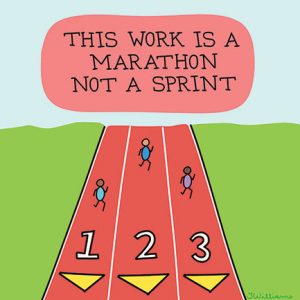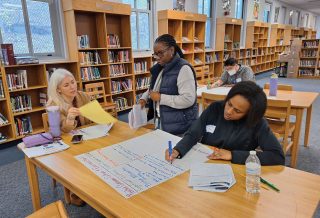FOCUS
Virtual networks follow paths to equity
By Mary Antón, Lee Teitel and Tamisha Williams
Categories: Collaboration, Continuous improvement, Learning communities, Reaching all studentsFebruary 2021
In the chaos and upheaval caused by the COVID-19 pandemic, it has been hard to keep a focus on race and equity in schools. And yet in this time of disruption of our very notion of what it means to be a teacher and how we do school, we recognize that keeping race and equity at the center of our work is essential. In this time of exhaustion and uncertainty, we find great hope for a future beyond the pandemic that is not a return to the status quo.
Our hope is rooted in the power of what the collective can do and in the roles we see virtual networks play in promoting that power. Virtual networks can inform and connect; they can nurture and disrupt. We need these actions to move forward individually and systemically to create a more equitable world.
Networks are powerful real-world examples of the value of collectivism at work. Networks bring together people across geography, ability, and types of institutions. They harness the collective knowledge and wisdom of an array of experienced practitioners, experts, individuals, and teams. Individuals benefit from the experience of the whole, and the whole grows stronger through collaboration. Out of individualism and isolation, collectives have been forming in ways that were rarely possible when educators were bounded by time and geographic space.
For educators of color, the opportunity to lean into affinity and multiracial spaces to collectively work toward dismantling racism has led to collective healing. For white educators, these networks offer a space in which they can be challenged and learn from collective wisdom without overburdening the often-limited number of BIPOC (Black, Indigenous, and People of Color) colleagues in their settings.
This shift from embracing norms of individualism (“I can figure this out myself”) to collectivism (“We are in this together, and together we are stronger”) represents a profound philosophical shift and is a shift to cultural ways of being often associated with Black and Brown communities throughout the world.
Understanding the pandemic virtual space
As national and world attention focused on acknowledging racial disparities in spring 2020, experts and institutions stepped up to answer the knowledge void. Experts offered free webinars, lectures, and protocols. Access to people outside of one’s own geography and network exploded. Zoom became as normal as texting.
Educators throughout the summer sought opportunities to step up and do their part. Offered at low or no cost throughout the summer, Black authors and experts shared wisdom not readily available before. For educators seeking to address racial inequity, virtual technology created the feel of a kid in a virtual candy store. Not only did we have this array of choices, but in the virtual world, we could sign up for everything and learn on our own schedule. Even as this virtual candy story supported learning through access to powerful speakers and fresh, engaging content, it could prove overwhelming to sort through the wealth of options.
Virtual networks vary
Thinking about the work that we have done in 2020, we recognize that we have embraced the power of collectivism to help us to “dismantle the master’s house” (Lord, 2018). Our experiences participating in, organizing, and learning from virtual networks suggest that networks can vary on a set of dimensions — not binary, but as points on a continuum. Matching them to what we need as individuals, schools, or districts can be helpful. What follows are ways to organize the different shelves in the virtual candy store.
Network examples from our collective practice
Through our practices, we have facilitated a variety of networks and offer these examples as ways to deepen your thinking about their similarities and uses.
Informal network:
CROSS-COUNTRY LEADERS
Mary Antón started Cross-Country Leaders in March 2020 as California shut down. This biweekly network provided a space for leaders to share, support, and hold each other accountable to continue their commitment to racial equity. Members invited colleagues to join, formed their own networks, and leaders embraced the realization that district decisions sometimes continued to perpetuate the marginalization of communities of color.
This network offered ways to think together with others in shared spaces by centering conversation around questions such as: How do we create belongingness when all certainty is gone? How can we advocate for our staff and students of color? How do we ensure race is centered in each decision we make? Of critical importance in these was a central theme: Who is thriving in the midst of this upheaval? How can we learn both from their thriving and from uncovering our biases and assumptions about who needs help?

Semistructured network:
A SUMMER WORKBOOK FOR EDUCATORS
Tamisha Williams designed the WORKbook (gumroad.com/l/educatorWORKbook) for staff at one school, then broadened it to share across schools and systems. This guide consolidates resources, provides guidance, and points to ways that educators can dig into the underpinnings of racial inequities in the country and schools.
Williams set up a series of four companion meet-ups — virtual professional learning communities — for educators to work through and discuss the content of the WORKbook, in both full group and racial affinity spaces. Group interaction and dialogue drive the learning.
Semistructured network:
SOUTHEASTERN CONNECTICUT SUPERINTENDENT NETWORK: PERSONAL AND PROFESSIONAL WORK ON RACE, RACISM AND EQUITY
When a white superintendent doing equity improvement cycle work in her district with Lee Teitel found that she lacked the breadth of knowledge and the language around equity to frame her leadership moves, she suspected her fellow superintendents in the region felt the same. She and Teitel co-designed a monthly network that addresses how these white superintendents, most of whom grew up in the white communities they serve, can support each other personally, professionally, and practically to disrupt and address issues of racism and inequity.
Structured network:
RIDES INTENSIVE CLINICS
Before the pandemic, Teitel guided schools and districts though structured, data-driven, race-focused equity improvement cycles, an approach developed with colleagues in Harvard’s Reimagining Integration: Diverse and Equitable Schools (RIDES) project. During the pandemic, the tools and approaches remain the same, but the delivery system changed significantly.
Instead of meeting the needs of six to eight schools a year through a costly on-campus and hybrid institute, RIDES offers a series of free week-long intensive clinics that support over 200 educators in 40 schools. Teitel, Antón, and others on the RIDES team now offer independent networks that use similar approaches but, rather than being place-based, can bring together schools from across the country. Teams learn to work within their schools and districts and collaborate with teams from other settings to build a sense of community, share ideas and tools for racial equity, and deepen accountability.
Lessons from virtual networks
Our ability to come together in community provides perspective and strength we did not have before. Here are some of the things the past year has taught us.
The ability to come together in community provides perspective and strength. Here are some lessons learned from virtual networks. #LearnFwdTLP Share on XMake it fit your time and budget. Collaboration doesn’t have to be expensive, time-consuming, or led by national experts. Networks only cost the time of the convener to set it up. In this time of isolation, our need to connect is palpable.
Diverse viewpoints spur thinking. We all benefit by focusing beyond a limited sphere of colleagues that we see every day. Learning across schools, districts, and states results in rapid sharing of resources, ideas, and ways to support students and teachers.
Everyone benefits. BIPOC benefit from collaboration and solidarity; white people from opportunities to talk about racism and white privilege without leaning on BIPOC.
It’s a safe space for teams. Teams benefit from joining networks together, honing their shared focus, and being stretched by the experiences of colleagues from other schools and districts. Guided by the belief that deep work on race and equity must take place institutionally, RIDES networks create spaces that teams need to both deepen their internal work and benefit from the work and insight of others.
Be in it for the long haul. The work to advance racial equity is a marathon, not a sprint. To make consistent and ongoing progress, equity work must be a part of the fabric of our practices, policies, and procedures. Teachers and administrators need to develop skills and trust to talk across racial lines about dismantling privilege and about race and its impact. Collaboration allows us to see the parts of the whole that each is engaged in and imagine a whole that puts all the parts together.
Harnessing the power of virtual networks
Successfully navigating the virtual candy store requires three things: clarity of focus and a strong internal compass; thoughtful self-assessment of the needs and strengths of the individuals and teams in your setting; and deep understanding of which options might work best for you and when.
There isn’t one “right” network. Think about what will be most helpful in your context to support reaching your vision. Amidst the chaos, confusion, and challenges of running schools and districts during the pandemic, leaders are struggling to keep a focus on sustained efforts toward antiracism and equity. Finding, picking, or forming the right network isn’t always easy. As you think about your own learning, your context, and your staff’s needs, consider your vision and where you are on your journey.
The urgency for centering race is often offset by the challenges of the pandemic. To lean into discomfort and take a marathon view of equity improvement requires that we recognize we are on a recursive cycle of continual improvement.
We are in a time of great opportunity. Whether learning is in person or virtual doesn’t have to be the defining factor in our progress. Virtual networks have the potential to provide free or low-cost opportunities to:
Provide alternatives to counter the way things have always been done;
Provide affinity spaces to thrive (BIPOC) or affinity spaces to understand and question (white);
Support essential content and research that challenge the status quo;

Provide places for teams to build trust and try on challenging and often context-counter views and ideas; and
Provide support outside of your institution for engaging in recurring cycles of equity improvement.
The lessons we are learning from educators give us hope. Decisions about the everyday aspects of running school are intertwined with the recognition that race matters and inequities exist. If we continue to hold these up for inspection, we can challenge both individual teacher assumptions and invisible institutional white norms that lift up some and oppress others. In the disruption of schools as we know them, we have an opportunity to dismantle racism as has never been presented before.
References
Lord, A. (2018). The master’s tools will never dismantle the master’s house. Penguin Classics.
Categories: Collaboration, Continuous improvement, Learning communities, Reaching all students
Recent Issues
LEARNING DESIGNS
February 2025
How we learn influences what we learn. This issue shares essential...
BUILDING BRIDGES
December 2024
Students benefit when educators bridge the continuum of professional...
CURRICULUM-BASED PROFESSIONAL LEARNING
October 2024
High-quality curriculum requires skilled educators to put it into...
LEARNING TO PIVOT
August 2024
Sometimes new information and situations call for major change. This issue...














